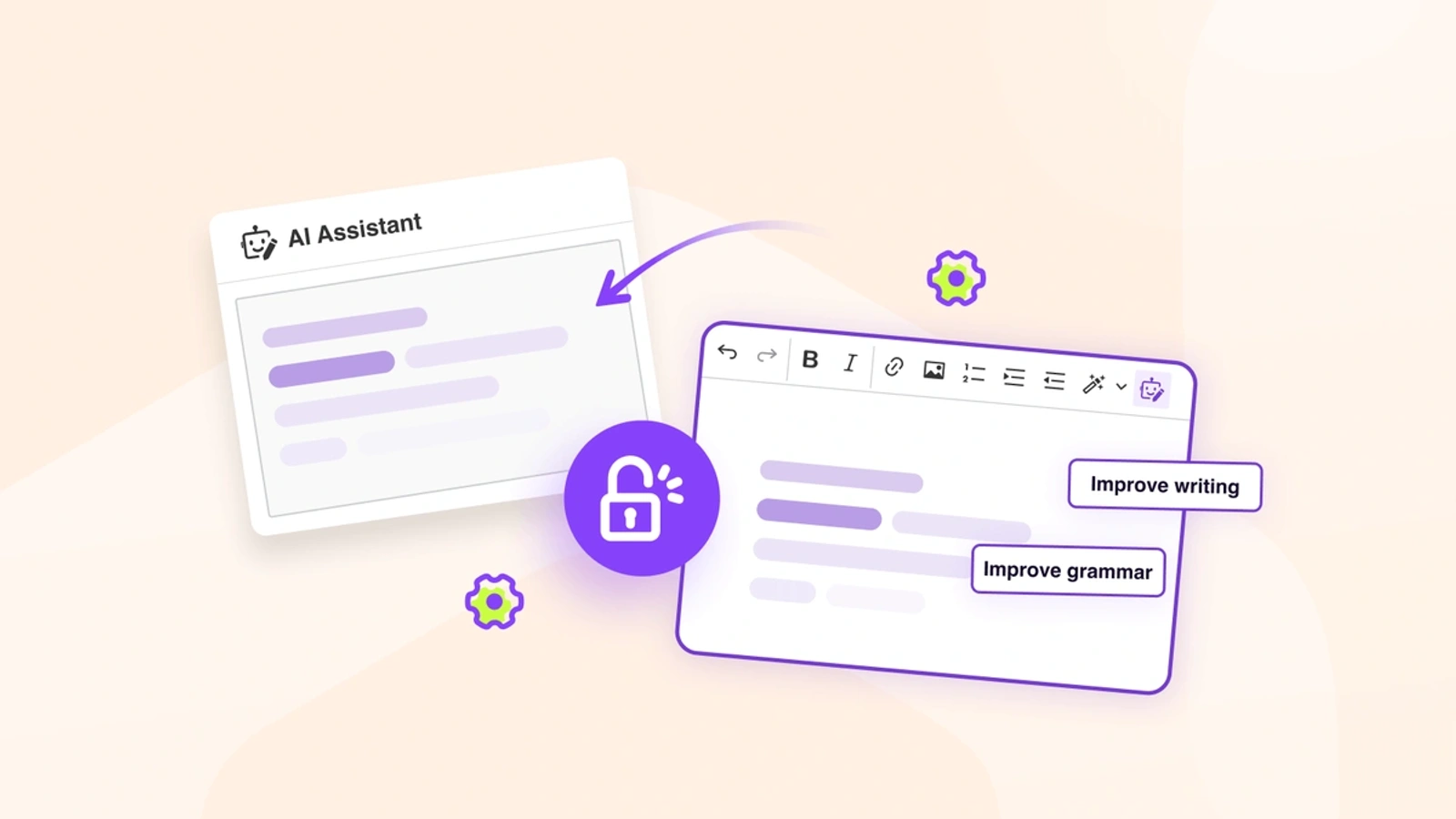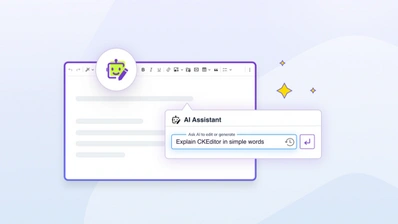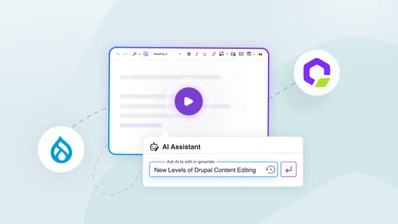Unlocking AI Content Creation with CKEditor 5: Highlights from the Latest Webinar

Artificial Intelligence (AI) is revolutionizing AI content creation, and CKEditor 5 is leading the charge. In our latest webinar, “Designing AI Prompts for Content Creation,” hosted by Mrina Sugosh, Developer Relations Manager for CKEditor, and Dan Wilson, Senior Product Marketing Manager for CKEditor, we explored how AI can be integrated into content creation workflows.
During the webinar, Mrina and Dan shared their insights into integrating AI into CKEditor 5. The session covered the six major challenges the engineering team faced while building generative AI into the latest release of CKEditor, such as difficulties in writing effective prompts and maintaining consistent formatting. They discussed solutions like pre-defined prompts and rigorous testing to enhance user experience. They also highlighted the importance of creating tailored user experiences and clear error handling to support users with varying levels of AI familiarity.
The webinar emphasized the transformative potential of the CKEditor AI Assistant, showcasing its capabilities in context-aware editing, enhanced creativity tools, and personalized user experiences. By understanding the different segments of AI users and implementing strategies to meet their needs, CKEditor aims to revolutionize the AI content creation process.
Today, we’ll share the main takeaways from the webinar, focusing on the importance of pre-defined prompts, key challenges we faced during AI integration, and strategies for enhancing user experience. For a deeper dive, we encourage you to watch the full webinar.
The Significance and Applications of Pre-Defined Prompts
Pre-defined prompts are a cornerstone of the CKEditor AI Assistant. They play a crucial role in making AI accessible and useful to a broad range of users, from beginners to seasoned professionals. Here’s why they are indispensable:
- Ease of Use for Beginners: Pre-defined prompts simplify the user experience for those unfamiliar with AI or prompt engineering. Commands like "improve writing," "make this shorter," and "simplify language" are intuitive and reduce the learning curve, fostering wider adoption. These prompts enable users to harness the power of AI content creation without needing extensive technical knowledge, making advanced content creation tools accessible to everyone.
- Consistency and Efficiency: For experienced users, pre-defined prompts ensure consistent output and save valuable time. They eliminate the need to craft new prompts for repetitive tasks, thus boosting productivity. With standardized commands, users can rely on getting predictable results, streamlining their workflow and allowing them to focus on more creative aspects of content creation.
- Enhanced Content Quality: Utilizing well-crafted prompts enables users to produce high-quality content that adheres to desired standards, whether it’s for tone, clarity, or grammatical accuracy. Pre-defined prompts help maintain a uniform style across different pieces of content, ensuring that everything produced using the CKEditor AI Assistant meets high editorial standards. This is particularly useful for teams working on collaborative projects where consistency is key.
- Support for Complex Tasks: Pre-defined prompts can also handle more complex content editing tasks, such as restructuring paragraphs, refining arguments, or enhancing readability. These advanced capabilities support users in achieving professional-grade results with minimal effort. By simply selecting the appropriate prompt, users can transform their content to better suit their audience and objectives, making the writing process both efficient and effective.
Pre-defined prompts are an essential feature of the CKEditor AI Assistant, making it a versatile tool that caters to the diverse needs of its users. Whether your users are looking to enhance their writing or streamline their workflow, these prompts provide a robust solution to improve the quality and efficiency of AI content creation.
Overcoming AI Integration Challenges
Integrating AI into CKEditor 5 presented several challenges. Our engineering team identified and overcame six major hurdles, five of which were particularly noteworthy:
- Prompt Writing Difficulties: Writing effective AI prompts is a skill that many users lack. Research shows that only 20% of the English-speaking population can write good prompts. We addressed this by integrating pre-defined prompts to assist those less skilled in prompt engineering. These pre-defined prompts guide users in generating precise instructions for the AI, ensuring that even those without technical expertise can benefit from the advanced capabilities of the AI Assistant. This approach democratizes access to AI tools, allowing a broader audience to leverage AI for content creation.
- Unpredictable AI Responses: Generative AI often produces inconsistent or unexpected results. This unpredictability can frustrate users and disrupt workflows. We tackled this by implementing rigorous testing and continuous refinement of prompts based on user feedback. By analyzing user interactions and refining the prompts accordingly, we ensured that the AI Assistant provides reliable and relevant outputs. This iterative process involved close collaboration between our developers and users, fostering a feedback loop that continually enhances the AI's performance and reliability.
- Inconsistent Formatting: Maintaining consistent response formatting is crucial, especially for rich text editors. Minor variations in prompts can lead to drastically different outputs, affecting usability. We resolved this by specifying output formats in detail within each prompt, ensuring reliable and predictable formatting. By standardizing the output structure, we enabled users to integrate AI-generated content into their existing workflows without additional formatting adjustments. This consistency is particularly important for applications whose users need to maintain specific styling and layout standards in their documents.
- Handling Diverse Content Types: CKEditor users often work with a variety of content types, from simple text to complex multimedia documents. Ensuring the AI Assistant could handle this diversity was another challenge. We addressed this by training the AI on a wide range of content scenarios, allowing it to adapt its responses to different content types effectively. This adaptability ensures that users receive accurate and contextually appropriate suggestions, regardless of the content they are working on.
- User Trust and Adoption: Building trust in the AI's capabilities and encouraging adoption were also significant challenges. To overcome this, we focused on transparency and user education. We provided detailed documentation and interactive tutorials to help users understand how to use the AI Assistant. By showcasing successful use cases and demonstrating the AI's reliability, we built user confidence in the tool, driving higher adoption rates.
By addressing these challenges head-on, we have developed an AI Assistant that not only enhances AI content creation but also aligns with the diverse needs of our user base. Our commitment to continuous improvement and user-centric design ensures that the CKEditor AI Assistant remains a powerful tool for content creation.
Strategies for Enhancing Your Experience in the Content Creation Process
Creating an intuitive and engaging user experience with AI requires a focused approach to meet the needs of both AI enthusiasts and novices. Here are five strategies discussed during the webinar:
- User Segmentation and Tailored Experiences: We identified four segments of AI users: those unfamiliar with AI, skeptics, casual users, and AI experts (referred to as "AI ninjas"). By understanding these segments, we tailored the AI Assistant to meet diverse user needs, ensuring accessibility and functionality across all user levels. For example, beginners receive more guided interactions and educational resources, while AI ninjas have access to advanced customization options that leverage their expertise.
- Pre-Prompt Instructions: To mitigate issues with response unpredictability and formatting, we employed a "pre-prompt prompt." This set clear guidelines for the AI on how to execute tasks, ensuring consistent and accurate outputs. This approach not only improved the quality of the AI’s responses but also enhanced user trust and satisfaction. This method helps bridge the gap between different user expertise levels and promotes a more cohesive user experience.
- Error Handling and User Support: Clear and user-friendly error messages are crucial in maintaining a positive user experience. Instead of technical jargon, users receive informative notifications with support options, minimizing frustration and encouraging continued use of the AI features. We focused on making error messages actionable, providing users with steps to resolve common issues quickly.
- Interactive Tutorials and Educational Content: To further enhance user experience, we developed interactive tutorials and comprehensive educational content. These resources guide users through the various features of the AI Assistant, demonstrating practical applications and best practices. By offering hands-on learning opportunities, we empower users to explore the full potential of the AI Assistant, boosting their confidence and proficiency.
- Feedback-Driven Development: We actively encourage users to provide feedback on their experiences with the AI Assistant. This feedback is instrumental in guiding our development efforts, allowing us to make continuous improvements based on real user needs and preferences. By fostering a collaborative relationship with our user community, we ensure that the AI Assistant evolves in a way that genuinely supports and enhances their content creation processes.
These strategies collectively ensure that the CKEditor AI Assistant provides an engaging, reliable, and user-friendly experience. By focusing on user segmentation, structured instructions, clear support, educational content, and feedback-driven development, we are committed to making AI for content creation a valuable and accessible tool for all our users.
Exploring CKEditor 5’s AI Assistant
The CKEditor AI Assistant is designed to revolutionize the AI content creation process. By integrating advanced AI capabilities, users can benefit from:
- Context-Aware Editing: The AI Assistant understands the context of the content and provides relevant suggestions, making the editing process smoother and more intuitive. This capability allows users to maintain a consistent tone and style throughout their documents, enhancing the overall readability and coherence of their content.
- Enhanced Creativity Tools: From generating new ideas to refining existing content, the AI Assistant acts as a creative partner, helping users produce high-quality content efficiently. Whether your users need assistance brainstorming topics, expanding on key points, or polishing your prose, the AI Assistant offers valuable input that sparks creativity and improves content quality.
- Personalized User Experience: By learning from user interactions, the AI Assistant offers personalized recommendations and improvements, tailored to individual user preferences and writing styles. This personalization ensures that each user receives suggestions that are most relevant to their unique needs, making the AI Assistant an indispensable tool for AI content creation.
Demo CKEditor’s AI Assistant Features Today
To experience the power of AI-driven content creation firsthand, CKEditor offers a demo page where you can try out some of the AI Assistant features included with this premium offering. AI Assistant integrates seamlessly into your WYSIWYG editor, enabling you to write, rephrase, explain, translate, and summarize content without leaving the editor.
Harnessing advanced models from OpenAI, Azure, and Amazon Bedrock, CK Editor’s AI Assistant integrates with your custom AI models. Its simple plugin-based integration is both fully customizable and extensible, providing a tailored AI experience to suit your specific needs.
You can also choose from ready-to-use optimized prompts to change tone and style, fix grammatical errors, summarize content, and more. Alternatively, you can create your own detailed prompts to generate complex, custom content. This flexibility allows you to integrate the model of your choice, including OpenAI’s GPT-3.5 and GPT-4, Azure OpenAI service, and Amazon Bedrock service.
The AI Assistant is designed to fit various use cases, from content management systems (CMS) to document management systems (DMS) and customer relationship management (CRM) platforms. For instance, you can go from idea to draft with a single prompt within your CMS, make faster edits by changing tone and style, and fix grammatical errors efficiently. In a DMS, you can ensure documents are easy to find and read with automatic translation and AI-powered explanations of complex text. Or get customer insights faster in your CRM with summaries of account notes and write better client communications using the tool’s language and tone settings.
Visit CKEditor’s demo page to explore these AI Assistant features and see how they can revolutionize your content creation process.
Wrapping Things Up
The integration of AI into CKEditor 5 marks a significant advancement in AI content creation technology. The pre-defined prompts, meticulous prompt engineering, and user-centric design strategies highlighted in the webinar demonstrate our commitment to enhancing user experience and productivity. As AI continues to evolve, CKEditor remains at the forefront, providing innovative tools that empower users to create, edit, and manage content with unprecedented ease and efficiency.
Don’t miss out on the full insights from our webinar. Watch it here and explore how CKEditor 5’s AI Assistant can transform your content creation process.
For more information, visit our website or contact our support team.


